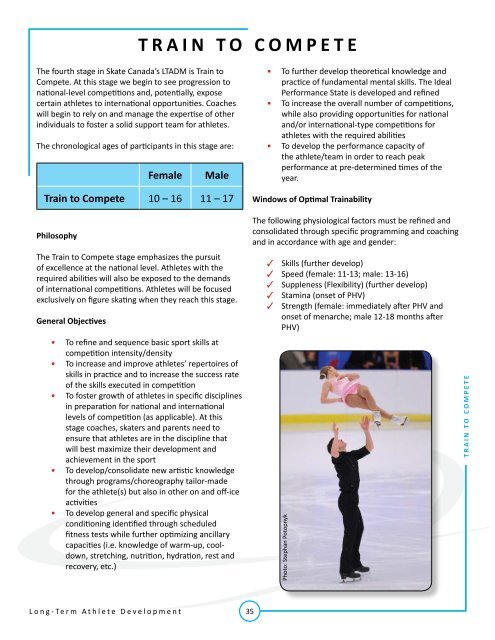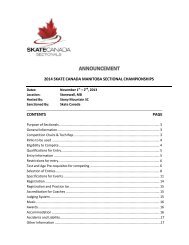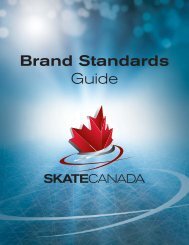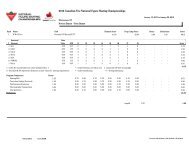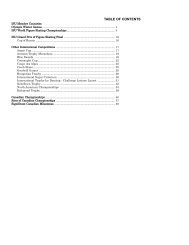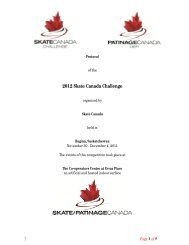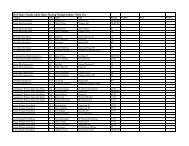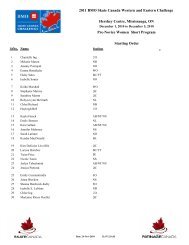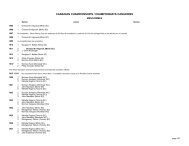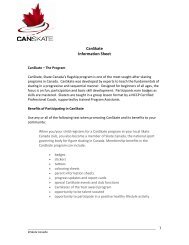LONG-TERM ATHLETE DEVELOPMENT - Skate Canada
LONG-TERM ATHLETE DEVELOPMENT - Skate Canada
LONG-TERM ATHLETE DEVELOPMENT - Skate Canada
You also want an ePaper? Increase the reach of your titles
YUMPU automatically turns print PDFs into web optimized ePapers that Google loves.
The fourth stage in <strong>Skate</strong> <strong>Canada</strong>’s LTADM is Train to<br />
Compete. At this stage we begin to see progression to<br />
national-level competitions and, potentially, expose<br />
certain athletes to international opportunities. Coaches<br />
will begin to rely on and manage the expertise of other<br />
individuals to foster a solid support team for athletes.<br />
The chronological ages of participants in this stage are:<br />
L o n g - Te r m A t h l e t e D e v e l o p m e n t<br />
865 Sheord Road, Ottawa, Ontario K1J 1H9<br />
Phone 613.747.1007 I Toll Free 1.888.747.2372 I Fax 613.748.5718 I Toll Free Fax 1.877.211.2372<br />
Female Male<br />
Train to Compete 10 – 16 11 – 17<br />
Philosophy<br />
The Train to Compete stage emphasizes the pursuit<br />
of excellence at the national level. Athletes with the<br />
required abilities will also be exposed to the demands<br />
of international competitions. Athletes will be focused<br />
exclusively on figure skating when they reach this stage.<br />
General Objectives<br />
T R A I N T O C O M P E T E<br />
• To refine and sequence basic sport skills at<br />
competition intensity/density<br />
• To increase and improve athletes’ repertoires of<br />
skills in practice and to increase the success rate<br />
of the skills executed in competition<br />
• To foster growth of athletes in specific disciplines<br />
in preparation for national and international<br />
levels of competition (as applicable). At this<br />
stage coaches, skaters and parents need to<br />
ensure that athletes are in the discipline that<br />
will best maximize their development and<br />
achievement in the sport<br />
• To develop/consolidate new artistic knowledge<br />
through programs/choreography tailor-made<br />
for the athlete(s) but also in other on and off-ice<br />
activities<br />
• To develop general and specific physical<br />
conditioning identified through scheduled<br />
fitness tests while further optimizing ancillary<br />
capacities (i.e. knowledge of warm-up, cooldown,<br />
stretching, nutrition, hydration, rest and<br />
recovery, etc.)<br />
35<br />
• To further develop theoretical knowledge and<br />
practice of fundamental mental skills. The Ideal<br />
Performance State is developed and refined<br />
• To increase the overall number of competitions,<br />
while also providing opportunities for national<br />
and/or international-type competitions for<br />
athletes with the required abilities<br />
• To develop the performance capacity of<br />
the athlete/team in order to reach peak<br />
performance at pre-determined times of the<br />
year.<br />
Windows of Optimal Trainability<br />
The following physiological factors must be refined and<br />
consolidated through specific programming and coaching<br />
and in accordance with age and gender:<br />
3 Skills (further develop)<br />
3 Speed (female: 11-13; male: 13-16)<br />
3 Suppleness (Flexibility) (further develop)<br />
3 Stamina (onset of PHV)<br />
3 Strength (female: immediately after PHV and<br />
onset of menarche; male 12-18 months after<br />
PHV)<br />
Photo: Stephan Potopnyk<br />
T R A I N T O C O M P E T E


